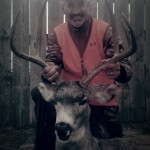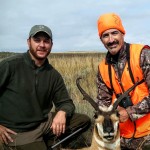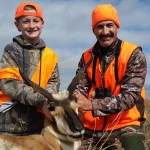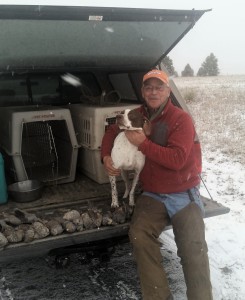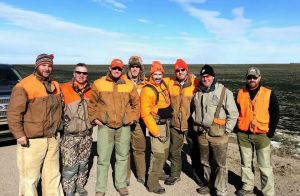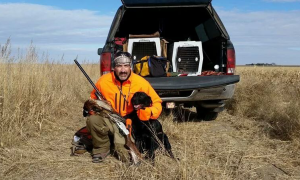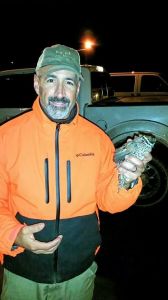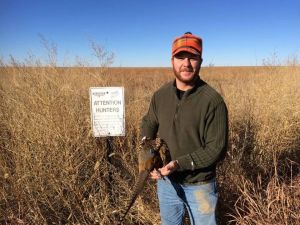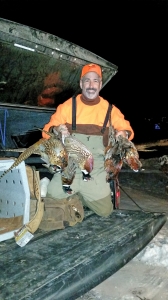The talk of a South Texas quail hunt started in the summer of 2014. Years of arid weather had decimated the indigenous quail population, but a wet 2013 brought back habitat necessary for the game birds to successfully rebound. The Cage Ranch would be the target destination. Months of careful planning had 16 hunters heading to El Indio, Texas in January of 2015. 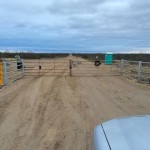
Day 1 – Arriving with Anticipation
Our flight into San Antonio landed in mid-afternoon. After touching down, the men picked up our three rented SUVs, and departed for the two and one half hour drive to the Ranch. It was dark, cold and damp when we met Bob at the main gate at around 7 pm. Everyone was pretty fired up to have arrived, and we were all ready to start hunting. We enjoyed a nice fajita dinner, then Colt, Tyler, Chance, Bob and I made an impromptu decision to do a little late night predator hunting. Armed with a Fox Pro game call, a spotlight and a Mossberg MMR Hunter, we made our way down a farm road in order to locate the appropriate place to set up. When we had a 360 degree perspective, we turned the truck off and started to call. Colt ran the spotlight, and I manned the rifle. It did not take long for the first coyote to appear, and move straight down the road toward us. Colt asked me multiple times if I saw the dog, but I could not pick up the movement in my scope. As the coyote crested a hill in the road, two red eyes became very visible. I positioned myself on the truck bed, and attempted to get into a stable position. Once the coyote exposed his right side, I slowly squeezed the trigger. Nothing happened. Panicked, I pulled the charging handle back, and peered down the action. The round was lodged in the upper receiver, and was not going anywhere. I did not need to pick my head up to understand that the coyote had bolted from the scene. Everyone was disappointed by none more bummed than me. I managed to get the unfired shell out of the action, only to see that the firing pin actually hit the round. With my confidence down, we made our way to another spot. Chance slowed down as we approached a cattle guard. Colt confirmed that the area was ideal so we stopped. Bob warned Tyler that we were parked on a cattle guard. As I stepped on the guard with my left foot, I slipped and fell through the iron bars. My Mossberg MMR Hunter and Leopold FX-II scope went flying. Outside of my pride, my knees, wrists and shins were hurting. It took me a few minutes to regain my composure. Colt grabbed the call, the spotlight, and told me to get ready. A constant ten minutes of the lightening jack call did not produce a stalking predator. Colt cycled to the whitetail/doe fawn distress then hit the light. I glanced to my right, saw a big coyote coming in hard. I immediately picked him up in my cross-hairs, and squeezed off a round. The slight recoil in pitch dark conditions caused me to lose sight of the animal. Colt thought my shot was successful so we drove out to the spot where he would have fallen. Fifteen minutes of searching produced nothing so we plodded along. It was close to 1 am, and we made a decision to make one last set. The lightening jack call was only on for about five minutes, when we picked up the coyote at one hundred yards to the left of the truck. The dog quickly weaved in and out of cover, trying to pick up the scent of the injured bunny while moving into a stiff wind. The animal stopped at about one hundred yards, but I could not pick him up in the spotlight. We lost him completely after he picked up our scent at about seventy five yards. Disappointed by my inability to execute, we headed back to camp in order to get some much needed sleep.
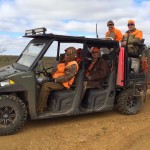
Day 2 – Relaxation
The three quail rigs arrived at 7:30 am. We were all moving a bit slowly after a late night of excess libations. The group devoured homemade burritos, while ensuring we awakened with the appropriate injection of coffee. The weather was cold (35 degrees) and wet. I had packed warm clothing, but not enough to protect myself from the nasty, unexpected wind chill. Quail rigs are outfitted with dog kennels, shotgun racks, drink holders, but you’re exposed to the elements. My unfettered excitement mitigated the impact of the freezing temperatures. Our guide, Darrell Layman, ran 14 dogs that included German Shorthaired Pointers, English pointers and 1 Labrador retriever. The pointing dogs worked about 100 yards around the truck quartering into the wind as they searched for quail scent. Darrell slowly drove the two track, staring at his GPS. Suddenly we heard him yell “a dog is on point about 125 yards to the west”. We piled out of the truck, loaded our shotguns, and moved towards the stationary dog. This was our first experience in thick, South Texas cover. The group’s walk turned into a sprint when Darrell told us Bubby was on the move. Every bush, plant and tree seemed to rip at my legs, arms and torso. While it did not deter my focus, the two inch thorns hurt. As we approached a clearing, I realized I was looking into the face of a big, black pig. Startled at 50 feet in front of me, he took a hard right, and bounded toward Jeff. I yelled “pig” as he made his way into the deep grass.
Darrell called us back to the truck when the scent diminished. He stated, “Blues run. They take the dogs on a ride. We need to find some Bobs”. We chased blues for the next 90 minutes, but did not force a bird into the air. Frustrated, I started to contemplate the movements of the evasive animals. It became obvious that once the dogs went on point, the covey was already stirring. With that in mind, I decided I would sprint to a flanking position, with the hope that a flush would result from the pressure of the dogs and me. As we continued to patrol the road, one dog went on point 30 yards ahead of us, and just off the road. I jumped off the top of the truck with my Weatherby SA-O8 Deluxe 28 gauge in my left hand, a shell in my right and two in my mouth. I started to run straight into the cover, keeping my eyes on the GSP stationed to my left. The covey flushed 20 yards in front of me, so I selected one bird, and squeezed the trigger. Shot number one missed behind the bird, but my follow up shell crushed the quail as he neared a mesquite tree. Darrell brought his lab in so he could hunt dead. Minutes later, we found the blue quail, and I did a quiet celebration; my first Texas quail was in the bag. We moved 4 more coveys before heading in for lunch. Most of the guys took at least one bird, with some getting a couple.
We attacked the homemade steak fajitas that had been prepared for us. As we were the first truck to come in for food, we awaited the arrival of the rest of the group. Unlike our gang, the rest of the crew did not experience the same in-field action. We discussed strategies before heading back out for the afternoon hunt. Midday did not produce the same findings as the morning had. The weather was warming, and we were all anticipating the late afternoon “golden hour”. Similar to pheasants, quail start to reveal themselves as the sun begins to set. They move toward the road in order to feed on seeds, and small rocks that aid in their digestion. This movement provides the hunter an opportunity to more easily locate the elusive prey. Understanding the near-term opportunity, we drove towards fertile ground just after 3 pm. It not take long for the dogs to discover birds, and for the hunters to knock a few out of the sky. We were in and out of the truck often, as coveys of quail seemed to be everywhere. One particular stalk was memorable for me. Darrell announced that both dogs were on point about 50 yards from our position. We all moved quickly into the woody, gnarly cover towards the stationary dogs. The covey jumped from their hidden position, and flew low to the west. It happened so quickly, the hunters did not get an opportunity to take a shot. We watched the quail land about 80 yards from our position, so we started to sprint with the excited dogs. As we approached some incredibly dense cover, the covey flew again. Three birds soared high and to my right. I locked in on the last bird and pulled the trigger of my shotgun. I watched the leg of the quail collapse, and he plummeted into the mesquite trees. Darrell brought the lab in, and Tony offered to help me search for the downed bird. About 15 minutes later, Tony noticed feathers at the base of a tree. We recovered my first Texas bobwhite quail!
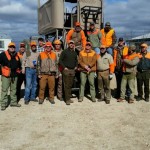
Day 3 – Into the Groove
Given Darrell’s day 2 success, we decided to run the second quail rig behind Darrell’s ATV. Some of our guys did not get into a lot of birds due to an ill prepared guide. To that point, we decided that all 11 of us would hunt together. As the dogs exposed coveys, we would alternate hunters. The morning temperature was warm, and so was the pursuit. Dogs found birds almost immediately. The morning action was steady, but we were not getting shots at the running blue quail. As we approached a new road, Darrell made the proclamation that the dogs were locked up. My group was up so we scrambled out of the ATV, and into the cover. I began my sprint as I thought I could once again cut off the scurrying covey. As I passed one GSP on point, I glanced into the trees in front of him to determine if the birds were attempting discretion. Almost immediately, I heard the covey take flight….behind me. I pivoted left, and watched the birds move to my right at about 20 yards. I picked a bird out, mounted my shotgun and quickly fired. The first shell made fatal impact, and the bird dropped into an open area. We found 5 more coveys before the day got warm, then the birds suddenly disappeared.
We had another delicious lunch awaiting us at camp. After scarfing down some steaks, we started to make an afternoon plan. A few of us noticed a significant amount of ducks in the many water tanks around the ranch. We decided to drive to each tank, and attempt to jump-shoot some waterfowl. Chad, Darren, Tony and I jumped into Ford’s quail rig, and made our way to the first waterhole. From 500 yards away, we could see about 25 ducks on the water. The plan was to sneak down towards the water staying camouflaged by the many trees. Once we got within 100 yards of the bank, Ford would drive over tank dam, and spook the ducks. With the strategy solidified, all of us loaded up and moved cautiously down the tree line. Once we all were in position, Ford drove slowly down the top of the dam. As expected, the ducks all took off, and flew high into the bright sky. Minutes later they circled around, and started to descend back into the pond. Many of the ducks took a flight path right over the set of trees we were sitting under. Chad slipped from his concealed position, and took the first duck in the group. The rest of us followed his lead, and shot the low flying birds. Given our immediate success, we made our way to a few other water tanks, and employed the same technique. With ducks in hand, we made our way back to camp to join the rest of the group for the late afternoon quail hunt. The group made a collective decision to hunt around the many deer feeders that are situated around the ranch. Most of the units were still loaded up with corn, so we knew that quail would head in that direction as the “golden hour” approached. Running two trucks in tandem, 11 of us made our way to wherever we saw a deer blind. As the afternoon progressed, the dog found birds. We were able to convert more of our shots as we became accustomed to the bird’s behaviors. Late in the day we made our way to a feeder we had not hunted yet. While we were picking off doves as they moved in waves off nearby mesquite trees, two of Darrell’s dogs went on point just yards from our position. Chad was the first to make his way into the brush, followed by Matt and me. A covey of bobwhites took off from the waste-high grass. I did not have a clear shot, but Chad did, and smoked a single bird. We continued to pursue the quail, but they quickly scattered to parts unknown. The sun was setting, and all of us realized our quail hunt was over.
Once the group finished dinner, decisions were made on who would be hunting what at night. I was a bit exhausted, and a few beers in front of the television sounded just fine. Tony, Darren and Jeremy decided to patrol the grounds, and look for a pig. Tony had lugged a big cooler to Texas, with the hope that he would fill it. At about 10 pm, my mobile phone rang. It was Tony, and they had taken a boar! Once they got back to the compound, the guys executed a flawless field dressing utilizing the gutless method. Tony and Darren had secured their meat.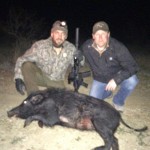
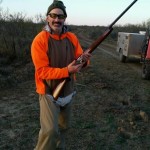
Day 4 – Heading Home
Most of the guys had an early afternoon flight back to Denver. To that point, they were up early and out the door. Some of us scheduled a late flight back home, so we decided to do some early morning hunting. Tyler had a doe tag that he wanted to fill. He had sat patiently in a few blinds on the prior day, but was not able to close the deal on a deer. He asked me to join him early Sunday morning on our final day in the field. At 6 am we made our way into the blind, and waited for shooting light. As the sunrise exposed the feeder, we watched two bucks start to eat. A third buck ventured in but no does appeared. We waited another 2 hours before Adam picked us up in order to head back to camp. Expedited packing commenced, and we loaded up the trucks for the 2.5 hour trip back to San Antonio.
The South Texas quail was a spectacular experience for everyone who participated. We got to see dogs expertly work brushy, gnarly thickets, forcing both quail to appear against their will. All of us were able to connect on at least one bird, while others put a few more in the bag. We enjoyed great meals, good beer, tasty cigars and a lot of laughs. Planning for the 2016 South Texas quail hunt at the Cage Ranch has already begun.
Video of the South Texas Quail Hunt
